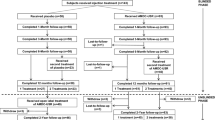Abstract
Introduction and hypothesis
Cell therapy for stress urinary incontinence (SUI) management has been experienced with encouraging results.
Methods
We conducted an open prospective study on 12 women presenting severe SUI with fixed urethra, after previous failed surgical management. Patients underwent intrasphincteric injections of autologous progenitor muscular cells isolated from a biopsy of deltoid muscle. Primary endpoint focused on safety (measurement of Q max variation after 3 months). Secondary endpoints assessed side effects and efficacy.
Results
No variation was diagnosed on Q max measurements. Efficacy data show that three of 12 patients are dry at 12 months, seven other patients are improved on pad test but not on voiding diary, and two patients were slightly worsened by the procedure. Quality of life was improved in half of patients.
Conclusions
Cell therapy for severe multioperated cases of SUI is a mini-invasive, feasible, and safe procedure that can improve urinary condition in as a second line therapy.


Similar content being viewed by others
Abbreviations
- BMI:
-
Body mass index
- ISD:
-
Intrinsic sphincter deficiency
- PFME:
-
Pelvic floor muscle exercises
- PVR:
-
Post-voiding residual
- Q max :
-
Maximum urinary flow rate
- QoL:
-
Quality of life
- SUI:
-
Stress urinary incontinence
- UI:
-
Urinary incontinence
- UPP:
-
Urethral pressure profile
- UTI:
-
Urinary tract infection
References
Abrams P, Cardozo L, Fall M, Griffiths D, Rosier P, Ulmsten U et al (2003) The standardisation of terminology of lower urinary tract function: report from the standardisation sub-committee of the International Continence Society. Urology 61:37–49
Norton P, Brubaker L (2006) Urinary incontinence in women. Lancet 367:57–67
Pajoncini C, Costantini E, Guercini F, Bini V, Porena M (2003) Clinical and urodynamic features of intrinsic sphincter deficiency. Neurourol Urodyn 22:264–268
Haab F, Zimmern PE, Leach GE (1996) Female stress urinary incontinence due to intrinsic sphincteric deficiency: recognition and management. J Urol 156:3–17
Shamliyan TA, Kane RL, Wyman J, Wilt TJ (2008) Systematic review: randomized, controlled trials of nonsurgical treatments for urinary incontinence in women. Ann Intern Med 148:459–473
Mariappan P, Alhasso A, Ballantyne Z, Grant A, N’Dow J (2007) Duloxetine, a serotonin and noradrenaline reuptake inhibitor (SNRI) for the treatment of stress urinary incontinence: a systematic review. Eur Urol 51:67–74
Wilson TS, Lemack GE, Zimmern PE (2003) Management of intrinsic sphincteric deficiency in women. J Urol 169:1662–1669
Kiilholma P, Chancellor MB, Makinen J, Hirsch IH, Klemi PJ (1993) Complications of Teflon injections for stress urinary incontinence. Neurourol Urodyn 12:131–137
Rogers RG (2008) Urinary stress incontinence in women. N Engl J Med 358:1029–1036
Pesce F (2004) Current management of stress urinary incontinence. BJU Int 94(S1):8–13
Torrente Y, Belicchi M, Marchesi C, Dantona G, Cogiamanian F, Pisati F et al (2007) Autologous transplantation of muscle-derived CD133+ stem cells in Duchenne muscle patients. Cell Transplant 16:563–577
Menasché P, Hagège AA, Scorsin M, Pouzet B, Desnos M, Duboc D et al (2001) Myoblast transplantation for heart failure. Lancet 357:279–280
Strasser H, Berjukow S, Marksteiner R, Margreiter E, Hering S, Bartsch G et al (2004) Stem cell therapy for urinary stress incontinence. Exp Gerontol 39:1259–1265
Praud C, Sebe P, Biérinx AS, Sebille A (2007) Improvement of urethral sphincter deficiency in female rats following autologous skeletal muscle myoblasts grafting. Cell Transplant 16:741–749
Peyromaure M, Sèbe P, Praud C, DeRocle G, Potin N, Pincet C et al (2004) Fate of implanted syngenic muscle precursor cells in striated urethral sphincter of female rats: perspectives for treatment of urinary incontinence. Urology 64:1037–1041
Yiou R, Yoo JJ, Atala A (2003) Restoration of functional motor units in a rat model of sphincter injury by muscle progenitor cell autografts. Transplantation 76:1053–1060
Yokoyama T, Yoshimura N, Dhir R, Qu Z, Fraser MO, Kumon H et al (2001) Persistence and survival of autologous muscle derived cells versus bovine collagen as potential treatment of stress urinary incontinence. J Urol 165:271–276
Chancellor MB, Yokoyama T, Tirney S, Mattes CE, Ozawa H, Yoshimura N et al (2000) Preliminary results of myoblasts injection into the urethra and bladder wall: a possible method for the treatment of stress urinary incontinence and impaired detrusor contractibility. Neurourol Urodyn 19:279–287
Carr LK, Steele D, Steele S, Wagner D, Pruchnic R, Jankowski R et al (2008) 1-year follow-up of autologous muscle-derived stem cell injection pilot study to treat stress urinary incontinence. Int Urogynecol J Pelvic Floor Dysfunct 19:881–883
Amarenco G, Arnould B, Carita P, Haab F, Labat JJ, Richard F (2003) European psychometric validation of the CONTILIFE: a quality of life questionnaire for urinary incontinence. Eur Urol 43:391–404
Oshima H, Payne TR, Urish KL, Sakai T, Ling Y, Gharaibeh B et al (2005) Differential myocardial infarct repair with muscle stem cells compared to myoblasts. Mol Ther 12:1130–1141
Conflicts of interest
Christelle Doucet is employed by Celogos. Christian Pinset is shareholder of Celogos and the inventor and the owner of the patent protecting the process of manufacturing cells. Sixtina Gil Diez de Medina received payment from HRA Pharma, a firm that holds shares in CELOGOS capital.
Author information
Authors and Affiliations
Corresponding author
Additional information
Philippe Sèbe and Christelle Doucet have contributed equally to this work.
Rights and permissions
About this article
Cite this article
Sèbe, P., Doucet, C., Cornu, JN. et al. Intrasphincteric injections of autologous muscular cells in women with refractory stress urinary incontinence: a prospective study. Int Urogynecol J 22, 183–189 (2011). https://doi.org/10.1007/s00192-010-1255-5
Received:
Accepted:
Published:
Issue Date:
DOI: https://doi.org/10.1007/s00192-010-1255-5




